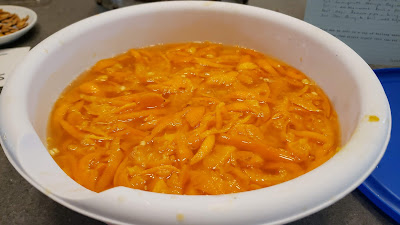We are past celeriac season here in the southern hemisphere but, if you happen to have one that has not gone to seed yet, this looks like a lovely way of eating it.
I might use lovage and kohlrabi because I have all the other ingredients. I love Yottam."Celeriac is probably my favourite root. It is delicate, yet very nutty, and has an elegant oily smoothness. Like all good vegetables, it is marvellous simply with a bit of olive oil. Here it works with the lentils and nuts to create a hearty autumn main course. Serve it warm, with a radish, cucumber and dill salad dressed with soured cream and olive oil. Or, allow it to cool down, then take it to work for lunch or on a picnic."
INGREDIENTS
- SERVES FOUR
- 60g whole hazelnuts (skin on)
- 200g Puy lentils
- 700ml water
- 2 bay leaves
- 4 thyme sprigs
- 1 small celeriac (650g), peeled and cut into 1cm chips
- 4 tbsp olive oil
- 3 tbsp hazelnut oil
- 3 tbsp good-quality red wine vinegar
- 4 tbsp chopped mint
- salt and black pepper
METHOD
- Preheat the oven to 140°C/Gas Mark 1. Scatter the hazelnuts on a small baking sheet and roast in the oven for 15 minutes. Let them cool down, then chop roughly.
- Combine the lentils, water, bay leaves and thyme in a small saucepan. Bring to the boil, then simmer for 15–20 minutes, or until al dente. Drain in a sieve. Meanwhile, in a separate saucepan, cook the celeriac in plenty of boiling salted water for 8–12 minutes, or until just tender. Drain.
- In a large bowl mix the hot lentils (if they have cooled down they won’t soak up all the flavours) with the olive oil, 2 tablespoons of the hazelnut oil, the vinegar, some black pepper and plenty of salt. Add the celeriac and stir well. Taste and adjust the seasoning.
- To serve straight away, stir in half the mint and half the hazelnuts. Pile onto a serving dish or in a bowl and drizzle the remaining hazelnut oil on top. Garnish with the rest of the mint and hazelnuts.
- To serve cold, wait for the lentils and celeriac to cool down before finally adjusting the seasoning and possibly adding some more vinegar, if you like. Add hazelnut oil, mint and nuts in the same way as when serving hot.













